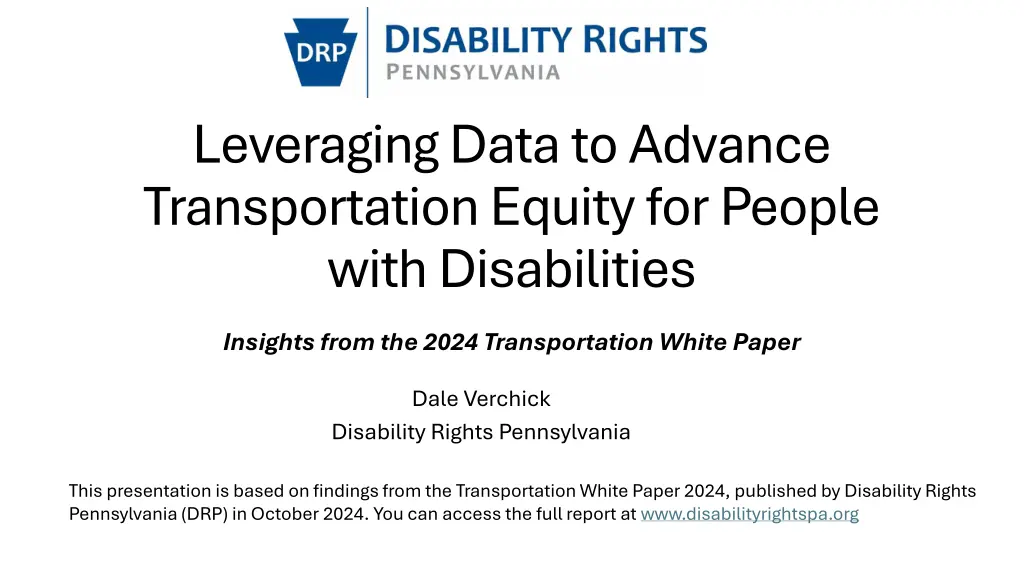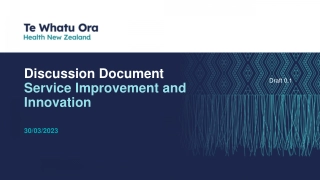
Leveraging Data for Transportation Equity & Disability Inclusion
Explore insights from the 2024 Transportation White Paper by Disability Rights Pennsylvania on advancing transportation equity for individuals with disabilities. Discover how data influences change, the role of transportation in employment, key findings from data sources, identified transportation challenges, and key complaints data from transit systems.
Download Presentation

Please find below an Image/Link to download the presentation.
The content on the website is provided AS IS for your information and personal use only. It may not be sold, licensed, or shared on other websites without obtaining consent from the author. If you encounter any issues during the download, it is possible that the publisher has removed the file from their server.
You are allowed to download the files provided on this website for personal or commercial use, subject to the condition that they are used lawfully. All files are the property of their respective owners.
The content on the website is provided AS IS for your information and personal use only. It may not be sold, licensed, or shared on other websites without obtaining consent from the author.
E N D
Presentation Transcript
Leveraging Data to Advance Transportation Equity for People with Disabilities Insights from the 2024 Transportation White Paper Dale Verchick Disability Rights Pennsylvania This presentation is based on findings from the Transportation White Paper 2024, published by Disability Rights Pennsylvania (DRP) in October 2024. You can access the full report at www.disabilityrightspa.org
Introduction & Purpose Introduction & Purpose Why transportation equity matters How data drives change Overview of key findings
The Role of Transportation in Employment The Role of Transportation in Employment Transportation as a bridge to employment opportunities Key Data Point: Key Data Point: PA employment rate for individuals with disabilities (39.4%) vs. national average (40.7%) How transit barriers impact workforce participation
Understanding the Data Sources Understanding the Data Sources Key Reports: Key Reports: Annual Disability Statistics Compendium (UNH) Travel Patterns of Adults with Travel-Limiting Disabilities (Bureau of Transportation Statistics, 2024) Transportation & Economic Characteristics of People with Disabilities in Pennsylvania (ACS, 2019-2021) DRP's Disability Advocacy Database (DAD) Importance of firsthand accounts and surveys
Transportation Challenges Identified Transportation Challenges Identified Employment Impact: Employment Impact: 71% of surveyed students cited transit as a barrier Poverty Disparities: Poverty Disparities: PA disability poverty rate (27.5%) vs. national average (25.4%) Accessibility Issues: Accessibility Issues: Common complaints in urban & rural transit services
Key Findings from Complaint Data Key Findings from Complaint Data Most Frequent Issues: Most Frequent Issues: Timeliness & Reliability (missed pickups/drop-offs) Driver Professionalism & Training Knowledge of Accessibility Features High Complaint Transit Systems: High Complaint Transit Systems: Southeastern Pennsylvania Transportation Authority (SEPTA) (4,848 complaints), Lehigh and Northampton Transportation Authority (LANTA) (1,522 complaints), Pittsburgh Regional Transit (PRT) (447 complaints)
Policy & Advocacy Applications Policy & Advocacy Applications How Protection & Advocacy (P&A) organizations can use this data: Policy Change: Advocate for stricter accessibility enforcement Funding Allocation: Support grant proposals for transit improvements Legal Action: Address discrimination in transit services
Case Study Case Study College Student Accessibility College Student Accessibility DRP survey: 94% of students rely on transit for classes 65% reported missing classes due to transit issues Advocacy need: Improved campus transit & paratransit services
Recommendations for Systemic Recommendations for Systemic Improvements Improvements Short Short- -Term Solutions: Term Solutions: Stricter enforcement of transit service quality Increased driver training on accessibility Long Long- -Term Policy Changes: Term Policy Changes: Expanding funding for accessible transit infrastructure Enhanced accountability for transit providers
Call to Action Call to Action For Policymakers: For Policymakers: Support legislation for improved transit funding For Advocacy Groups: For Advocacy Groups: Leverage statistics to push for reforms For Community Members: For Community Members: Share transportation challenges and accessibility issues
OUR MISSION Disability Rights Pennsylvania protects and advocates for rights of people with disabilities so that they may live the lives they choose, free from abuse, neglect, discrimination, and segregation. VISION STATEMENT A Commonwealth where people of all abilities are equal and free This presentation is funded through a SSA grant agreement. Although SSA reviewed this document for accuracy, it does not constitute an official SSA communication. This presentation was created at U.S. taxpayer expense.





















